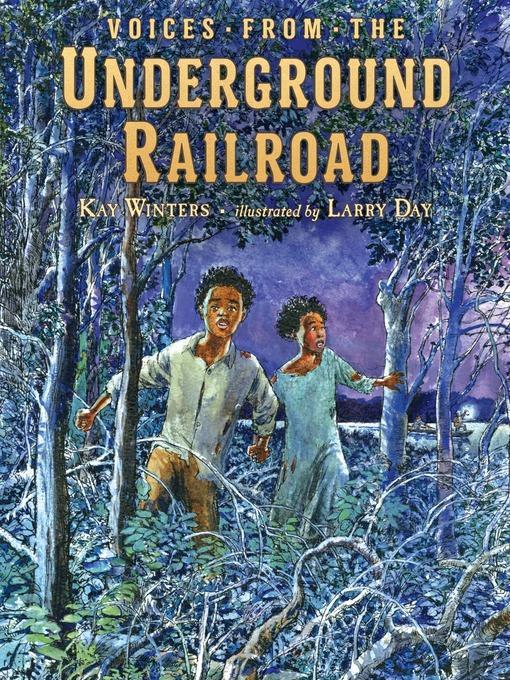
Voices from the Underground Railroad
فرمت کتاب
ebook
تاریخ انتشار
2018
Lexile Score
500
Reading Level
0-2
ATOS
3.1
Interest Level
4-8(MG)
نویسنده
Larry Dayشابک
9780735231160
کتاب های مرتبط
- اطلاعات
- نقد و بررسی
- دیدگاه کاربران
نقد و بررسی

October 23, 2017
In this companion to Colonial Voices and Voices from the Oregon Trail, Jeb and Mattie, two enslaved siblings in 1861 Maryland, are determined not to be “sold South” as their mother was. “Ain’t gonna happen,” says Ben. “Not to me. Not to Mattie./ Not gonna be sold like a pig or a plow./ We gotta run.” Helped by members of the Underground Railroad and pursued by bounty hunters emboldened by the Fugitive Slave Act, they travel up the Eastern seaboard to New Bedford, Mass., a city famous for its resistance to slavery. Winters chronicles their journey in a series of monologues from every player in the story, taking pains to reflect the latest scholarship on the Underground Railroad (which is further explained in the thoughtful afterword). Jeb and Mattie’s courage is front and center, and the movement is portrayed as encompassing both white helpers and free black people. The framing choices in Day’s warm, textured paintings sometimes blunt the emotional urgency in Jeb and Mattie’s flight, but readers will come away with a better understanding of the horror and hope that drove people to risk everything for freedom. Ages 7–9.

November 1, 2017
Jeb and Mattie, siblings living under slavery on a Maryland plantation, tell their story of escape on the Underground Railroad.The story, told in alternating voices, opens in 1861 with Jeb, a blacksmith and slave, whose free black co-worker and friend, Sam, is part of the Underground Railroad. When Mattie, a house slave, overhears plans to sell Jeb, the siblings know they must run to avoid their mother's fate: being sold south. They follow the North Star to Sam's house--the first stop on the Underground Railroad. From there, the different people they meet along the Railroad--conductor, station master, operative--are introduced, all with their own voices, one poem per spread. Slave owners and slave catchers also have voices, demonstrating historicity with the use of derogatory phrases for the slaves--caregivers should be ready to discuss these with child readers. Day's illustrations, which have the look of ink and watercolor, are filled with details that elicit a nearly tangible sense of time and place. After many trials and travels over land and sea, the siblings make it to their destination: freedom in New Bedford, Massachusetts. Well-utilized endpapers map the siblings' escape route. A good step-by-step portrayal of the dangers slaves were willing to risk for freedom and the complex, lifesaving organization that was the Underground Railroad. (historical notes, note from the author, references) (Picture book/poetry. 6-10)
COPYRIGHT(2017) Kirkus Reviews, ALL RIGHTS RESERVED.

January 1, 2018
Gr 4-6-Large illustrations accompany narrative poems told from a variety of viewpoints that revolve around the escape of Mattie and Jeb, two young enslaved siblings, from a master who wants to sell them to pay off gambling debts. Both Mattie and Jeb tend to speak and think in fragments with little to distinguish them from each other ("I work hard but get no pay./The master collects it."; "Never a kind word./Always afraid./I want to be free!/We gotta go."). In addition to the perspective of the conductor, stationmaster, and operative, Winters also provides the point of view of slave owner Clarinda and Angus and Rufus, two slave catchers. Their scenes are littered with disturbing language such as "Blast their black hides" and "Dumb darkies." The illustrations are done well but the didactic text struggles to balance a history lesson with emotional storytelling. Winters attempts to ramp up tension with lines such as "The hunt's begun!" but the overall feeling is one of exploitation. Mattie and Jeb do successfully make it up North where "Black people and white people are out and about/No one looks afraid!" VERDICT This book misses its mark.-Elizabeth Nicolai, Anchorage Public Library, AK
Copyright 2018 School Library Journal, LLC Used with permission.

December 15, 2017
Grades 2-5 When enslaved siblings Jeb and Mattie suspect that Jeb is going to be sold, they know they must flee. Brother and sister are owned by a master with gambling debts and ice in his veins. Structured as a series of free-verse poems, several voices narrate Jeb and Mattie's journey from Maryland to Connecticut, including an operative, a conductor, and slave catchers. Some readers might be surprised to learn that slavery was legal as far north as Maryland, as accounts of the Underground Railroad tend to originate in the South. The author points out that many escape stories feature white saviors of helpless black runaways, but revisionist histories, of which this book is one, show that many black people were involved as well. In that regard, this picture book is successful. Lush watercolor illustrations render the settings in gorgeous detail and capture characters' emotions in their postures and expressions. A map and historical notes provide supplemental information. Ashley Bryan's Freedom over Me (2016) and Lesa Cline-Ransome's Before She Was Harriet (2017) should prove excellent companion books.(Reprinted with permission of Booklist, copyright 2017, American Library Association.)

























دیدگاه کاربران